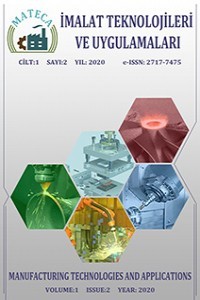Cam Elyaf Oranının Havacılık ve Uzay Uygulamaları için PA66 Polimerinin İşleme Özelliklerine Etkisi
Bu çalışmada %10, %20 ve %30 cam elyaf (GF) ile güçlendirilmiş poliamid 66'nın (PA66) işlenebilirliği incelenmiştir. İtme kuvvetini (Fz) ve yüzey pürüzlülüğünü (Ra) incelemek için 40, 80 ve 120 m/dak kesme hızları ve 0,06, 0,09 ve 0,12 mm/dev ilerleme hızları kullanılmıştır. Kaplamasız HSS ve TiAlN kaplı HSS kesici takımlar kullanılarak delme işlemleri yapılmıştır. Bu araştırmanın amacı, delme işlemleri sırasında kesme parametrelerinin (işmili hızı ve ilerleme hızı) ve takviye oranlarının itme kuvveti (Fz) ve yüzey pürüzlülüğü (Ra) üzerindeki etkisini araştırmaktır. İncelenen sonuçlara kesme parametrelerinin katkısını belirlemek için istatistiksel analiz kullanılmıştır. Delik kalitesi ve hasar mekanizmalarını incelemek amacıyla taramalı elektron mikroskobu (SEM) ile incelemeler yapılmıştır. Kaplamasız kesici takımla delinmiş %30 cam elyaf katkılı PA66 malzemesinde elde edilen yüzey pürüzlülük değerleri oldukça yüksektir. Delik yüzeylerinde yüksek lif kopma oranı, matris parçalanması ve diğer zorluklar, artan itme kuvvetiyle sonuçlanmıştır.
Anahtar Kelimeler:
Poliamid 66 (PA66), Cam elyaf (GF), Delme, İtme Kuvveti, Yüzey pürüzlülüğü
Influence of Glass Fiber Ratio on Machining Characteristics of PA66 Polymer for Aerospace Applications
This study examined the machinability of polyamide 66 (PA66) reinforced with glass fiber (GF) at 10%, 20%, and 30%. Cutting speeds of 40, 80 and 120 m/min and feed rates of 0.06, 0.09, and 0.12 mm/rev were used to examine thrust force (Fz) and surface roughness (Ra). Drilling operations were done using uncoated HSS and TiAlN coated HSS cutting tools. The goal of this research is to investigate the effect of cutting parameters (spindle speed and feed rate) and reinforcement ratios on thrust force (Fz) and surface roughness during cutting operations (Ra). Statistical analysis was used to determine the contribution of the cutting parameters to the results that were under investigation. For the purpose of examining the hole quality and damage mechanisms, scanning electron microscopy (SEM) was performed. The surface roughness values obtained in the 30% glass fiber added PA66 material drilled with an uncoated cutting tool were quite high. A high fiber rupture rate on the hole surfaces, matrix fragmentation, and other difficulties resulted in increased thrust force.
Keywords:
Polyamide 66 (PA66), Glass fiber (GF), Drilling, Thrust force, Surface roughness,
___
- 1. A. Bhardwaj, J. Vasselli, M. Lucht, Z. Pei, B. Shaw, Z. Grasley, X. Wei, N. Zou, 3D Printing of Biomass-Fungi Composite Material: A Preliminary Study, Manuf. Lett. 24 (2020) 96–99. https://doi.org/https://doi.org/10.1016/j.mfglet.2020.04.005.
- 2. R. M’Saoubi, D. Axinte, S.L. Soo, C. Nobel, H. Attia, G. Kappmeyer, S. Engin, W.-M. Sim, High performance cutting of advanced aerospace alloys and composite materials, CIRP Ann. 64 (2015) 557–580. https://doi.org/https://doi.org/10.1016/j.cirp.2015.05.002.
- 3. B.V. Lingesh, B.M. Rudresh, B.N. Ravikumar, Effect of Short Glass Fibers on Mechanical Properties of Polyamide66 and Polypropylene (PA66/PP) Thermoplastic Blend Composites, Procedia Mater. Sci. 5 (2014) 1231–1240. https://doi.org/10.1016/j.mspro.2014.07.434.
- 4. M.M.B. Hasan, A. Abdkader, C. Cherif, F. Spennato, Fibre hybrid composites consisting of discontinuous waste carbon fibre and continuous glass filaments developed for load-bearing structures with improved impact strength, Compos. Part A Appl. Sci. Manuf. 126 (2019) 105610. https://doi.org/https://doi.org/10.1016/j.compositesa.2019.105610.
- 5. C.I. Park, Y. Wei, M. Hassani, X. Jin, J. Lee, S.S. Park, Low power direct laser-assisted machining of carbon fibre-reinforced polymer, Manuf. Lett. 22 (2019) 19–24. https://doi.org/https://doi.org/10.1016/j.mfglet.2019.10.001.
- 6. N. Khanna, C. Agrawal, D.Y. Pimenov, A.K. Singla, A.R. Machado, L.R.R. da Silva, M.K. Gupta, M. Sarikaya, G.M. Krolczyk, Review on design and development of cryogenic machining setups for heat resistant alloys and composites, J. Manuf. Process. 68 (2021) 398–422. https://doi.org/https://doi.org/10.1016/j.jmapro.2021.05.053.
- 7. Y. Singh, J. Singh, S. Sharma, T.-D. Lam, D.-N. Nguyen, Fabrication and characterization of coir/carbon-fiber reinforced epoxy-based hybrid composite for helmet shells and sports-good applications: influence of fiber surface modifications on the mechanical, thermal and morphological properties, J. Mater. Res. Technol. 9 (2020) 15593–15603. https://doi.org/https://doi.org/10.1016/j.jmrt.2020.11.023.
- 8. G.L. Umesh, N.J. Krishna Prasad, B.M. Rudresh, M. Devegowda, Influence of nano graphene on mechanical behavior of PA66/PA6 blend based hybrid nano composites: Effect of micro fillers, Mater. Today Proc. 20 (2020) 228–235. https://doi.org/10.1016/j.matpr.2019.12.222.
- 9. N. Yaşar, M. Günay, Experimental investigation on novel drilling strategy of CFRP laminates using variable feed rate, J. Brazilian Soc. Mech. Sci. Eng. 41 (2019) 150. https://doi.org/10.1007/s40430-019-1658-2.
- 10. H. Yurtkuran, M.E. Korkmaz, M. Günay, Modelling and optimization of the surface roughness in high speed hard turning with coated and uncoated CBN insert, Gazi Univ. J. Sci. 29 (4) (2016) 987–995.
- 11. E.A. Rahim, H. Sasahara, A study of the effect of palm oil as MQL lubricant on high speed drilling of titanium alloys, Tribol. Int. 44 (2011) 309–317. https://doi.org/https://doi.org/10.1016/j.triboint.2010.10.032.
- 12. A.M. Abrão, P.E. Faria, J.C.C. Rubio, P. Reis, J.P. Davim, Drilling of fiber reinforced plastics: A review, J. Mater. Process. Technol. 186 (2007) 1–7. https://doi.org/10.1016/j.jmatprotec.2006.11.146.
- 13. V. Krishnaraj, A. Prabukarthi, A. Ramanathan, N. Elanghovan, M. Senthil Kumar, R. Zitoune, J.P. Davim, Optimization of machining parameters at high speed drilling of carbon fiber reinforced plastic (CFRP) laminates, Compos. Part B Eng. 43 (2012) 1791–1799. https://doi.org/https://doi.org/10.1016/j.compositesb.2012.01.007.
- 14. S. Prakash, Experimental investigation of surface defects in low-power CO2 laser engraving of glass fiber-reinforced polymer composite, Polym. Compos. 40 (2019) 4704–4715. https://doi.org/https://doi.org/10.1002/pc.25339.
- 15. J. Sheikh-Ahmad, J.P. Davim, Tool wear in machining processes for composites, in: H.B.T.-M.T. for C.M. Hocheng (Ed.), Woodhead Publ. Ser. Compos. Sci. Eng., Woodhead Publishing, 2012: pp. 116–153. https://doi.org/https://doi.org/10.1533/9780857095145.1.116.
- Yayın Aralığı: Yılda 3 Sayı
- Başlangıç: 2020
- Yayıncı: Mustafa GÜNAY
Sayıdaki Diğer Makaleler
Kritik Metan Yoğunluğu Tespit Robotu Prototip Tasarımı ve Üretimi
Farıj BEN SAOUD, Mehmet Erdi KORKMAZ
Ahmet Tolunay IŞIK, Ramazan CAKIROGLU
Cam Elyaf Oranının Havacılık ve Uzay Uygulamaları için PA66 Polimerinin İşleme Özelliklerine Etkisi
Gonca USLU, Muzaffer DEMİRHAN, Nafiz YAŞAR, Mehmet Erdi KORKMAZ
